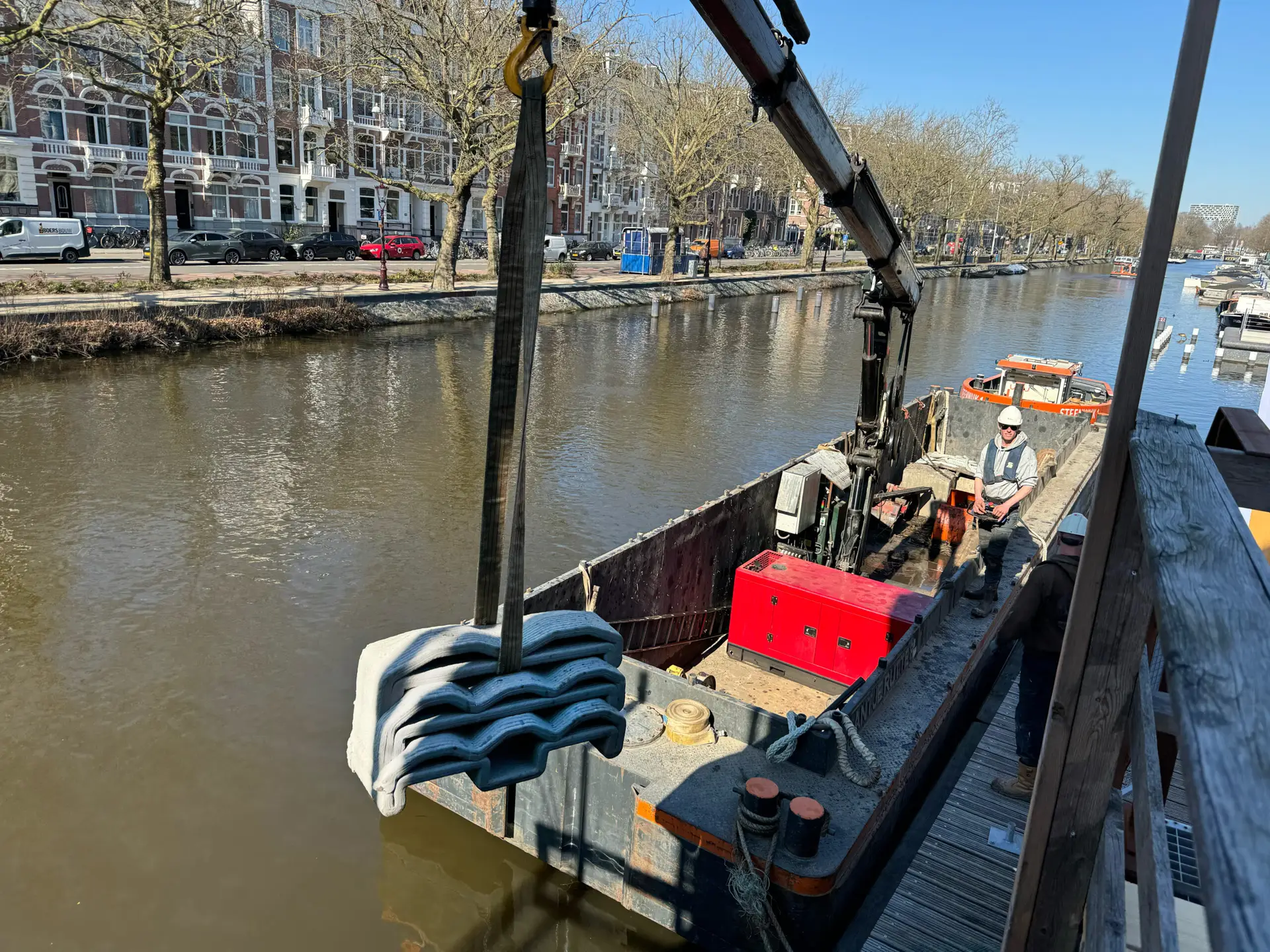A Hotel for Fish

A brand-new, sleek quay wall? That’s actually bad news for the fish living in Amsterdam’s canals. Species like the river bullhead rely on crumbling stones and uneven crevices to find shelter, spawn, and lay their eggs. That’s why, along the Jacob Catskade, 50 concrete fish hotels have been installed underwater, specifically designed to meet their needs.
These special fish hotels can be used by many fish species in the canals, but they are primarily intended for the river bullhead. This small, protected fish could be severely impacted by the construction works on the quay walls, to the point where it might even disappear from the Amsterdam canals altogether. Despite its name, the river bullhead is actually a small fish that is mostly active at night. It depends on cavities in the quay walls to lay its eggs and guard them until they hatch. Now that the city is renewing 200 kilometers of quay walls, there’s a risk these fish will lose their habitat. That’s why we’re using these infrastructure projects as an opportunity to make ecological improvements, not only for the river bullhead, but for the entire ecosystem in and around the canals.
A Rough Ceiling, Please
Jorine Noordman, specialist in nature-inclusive construction, advised the designers of the fish hotels on how to make the shelters as appealing as possible for the river bullhead. RAVON, the Dutch organization that studies reptiles, amphibians, and fish, provided additional input.
“We know the cavities need to be no larger than 8 centimeters,” Jorine explains. “And the river bullhead prefers a rough ceiling, so it can attach its eggs properly. The designers asked: But how rough exactly? Well, how do you explain that? We went to a hardware store and compared all kinds of sandpaper to figure out the right level of roughness. That gave the designers a clear reference. When we saw the first prototype, they pointed out that the surface was still a bit uneven and messy. Leave it like that, I told them. The more chaotic and irregular, the better for the river bullhead.”
3D Printing
The fish hotels are produced using a 3D printer that extrudes concrete. Essentially, it’s a large robotic arm with a nozzle that can create complex shapes.
“We actually built our 3D concrete printer using a robot that was originally designed for the automotive industry,” says Lynn van Norden, project manager for innovative nature-based solutions at Neolithic, the company that designed and produced the fish hotels. “We use the same machine to print staircases and wells, fully customized. These fish hotels are optimized for river bullheads and eels, but if the city wants, we can create shelters for other species too. Then we’ll just make the walls smoother and the openings a bit larger, it’s all flexible.”
Concrete is ideal for fish hotels in terms of structure, but of course less sustainable when it comes to production. “The concrete we use is relatively lightweight, and we only print exactly what’s needed,” Lynn explains. “But we’re also actively researching more sustainable alternatives, like concrete rubble from recycled materials.”
Eels Welcome Too
Other aquatic guests are welcome as well, like the eel. “The eel is in serious trouble. In the canals, they mostly seek a place to rest,” says Jorine. “They need to swim all the way to the Sargasso Sea, 6,000 kilometers away, to spawn. That journey takes an enormous amount of energy. In the canals, they try to regain strength and rest in preparation for the trip.”
There’s plenty of food in the fish hotels: the surfaces of the concrete structures encourage the growth of algae, aquatic plants, and mussels. These in turn attract water insects, snails, and small fish, which eels feed on. The fish hotels are also designed to keep larger predatory fish like pike, zander, and perch out. “Look, all fish need to eat,” says Jorine, “but I don’t want the fish hotel to turn into an all-you-can-eat buffet for predators. Those fish are much larger and bulkier than the river bullhead, so they simply can’t fit into the cavities in the concrete. Maybe the odd stickleback will slip in, but that’s no big deal.”
More Life in the Canals
Similar initiatives are being implemented in other parts of Amsterdam’s canals to support underwater biodiversity. For example, along the Nieuwe Herengracht, special fish baskets have been attached to the quay wall just below the waterline. These provide hiding places between branches, old leaves, basalt rocks, and stones. The fish hotels at the Jacob Catskade have been in the water since the end of 2024, along with two others installed beneath the jetty on the Singelgracht.
Jorine: “We’re conducting research into the effects of these measures together with the contractor, AMS, IBED (the Institute for Biodiversity and Ecosystem Dynamics), the University of Amsterdam, and Wageningen University. Is biodiversity really increasing? Is there more life in the canals, as we hope? We’re measuring that using DNA analysis, underwater cameras, and various sampling methods.”
The research will show whether the concrete fish hotels are more effective than the fish basketsor vice versa. The study will also look at the impact of other ecological measures, like the textured canal bottoms and additional habitat structures.
(This article is a translation of the original Dutch article on aandegrachten.amsterdam – https://aandegrachten.amsterdam/alle-ruimte-voor-de-vissen/)
